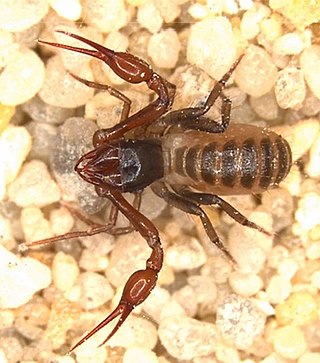
Chthoniidae is a family of pseudoscorpions within the superfamily Chthonioidea. The family contains more than 600 species in about 30 genera. Fossil species are known from Baltic, Dominican, and Burmese amber. Chthoniidae now includes the former families Tridenchthoniidae, and Lechytiidae which has been demoted to subfamilies.

The Queensland school mackerel is a species of fish in the family Scombridae. It is found in tropical waters of the western Pacific, largely confined to inshore coastal waters of southern Papua New Guinea and northern and eastern Australia, from Shark Bay and Onslow, Western Australia to Sydney, New South Wales. Queensland school mackerel commonly occur in waters down to 100 m, usually to 30 m, in depth. Specimens have been recorded at up to 100 cm in length, and weighing up to 12.2 kg.
Eiectus is a potentially valid genus of extinct short-necked pliosaur that lived in the Early Cretaceous period. Fossil material has been recovered from the Wallumbilla Formation (Aptian) of Queensland was initially classified under the related genus Kronosaurus until 2021.
Tyrannochthonius billhumphreysi is a species of pseudoscorpion in the Chthoniidae family. It is endemic to Australia. It was described in 2008 by Australian arachnologists Karen Edward and Mark Harvey.
Tyrannochthonius garthhumphreysi is a species of pseudoscorpion in the Chthoniidae family. It is endemic to Australia. It was described in 2008 by Australian arachnologists Karen Edward and Mark Harvey.
Tyrannochthonius souchomalus is a species of pseudoscorpion in the Chthoniidae family. It is endemic to Australia. It was described in 2008 by Australian arachnologists Karen Edward and Mark Harvey.
Tyrannochthonius laevis is a species of pseudoscorpion in the Chthoniidae family. It is endemic to Australia. It was described in 1966 by Austrian arachnologist Max Beier.
Tyrannochthonius cavicola is a species of pseudoscorpion in the Chthoniidae family. It is endemic to Australia. It was described in 1967 by Austrian arachnologist Max Beier.
Tyrannochthonius semihorridus is a species of pseudoscorpion in the Chthoniidae family. It is endemic to Australia. It was described in 1969 by Austrian arachnologist Max Beier.
Tyrannochthonius cavernicola is a species of pseudoscorpion in the Chthoniidae family. It is endemic to Australia. It was described in 1976 by Austrian arachnologist Max Beier.
Tyrannochthonius norfolkensis is a species of pseudoscorpion in the Chthoniidae family. It was described in 1976 by Austrian arachnologist Max Beier.
Tyrannochthonius kermadecensis is a species of pseudoscorpion in the Chthoniidae family. It was described in 1976 by Austrian arachnologist Max Beier.

Pseudotyrannochthonius is a genus of pseudoscorpions in the family Pseudotyrannochthoniidae. It was described in 1930 by Austrian arachnologist Max Beier.
Pseudotyrannochthonius queenslandicus is a species of pseudoscorpion in the Pseudotyrannochthoniidae family. It is endemic to Australia. It was described in 1969 by Austrian arachnologist Max Beier.
Sundochernes is a genus of pseudoscorpions in the Chernetidae family. It was described in 1932 by Austrian arachnologist Max Beier.
Sundochernes queenslandicus is a species of pseudoscorpion in the Chernetidae family. It is endemic to Australia. It was described in 1975 by Austrian arachnologist Max Beier.
Megachernes is a genus of pseudoscorpions in the Chernetidae family. It was described in 1932 by Austrian arachnologist Max Beier.
Megachernes queenslandicus is a species of pseudoscorpion in the Chernetidae family. It was described in 1948 by Austrian arachnologist Max Beier.


